New Products & Services
February 2011
Three new viscometers
for a range of applications
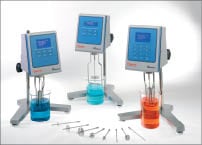
This new line of viscometers includes three models (photo): the Viscotester E, for automatic flow-curve measurements with full PC control; the Viscotester D, for routine viscosity measurements with data transfer; and the Viscotester C, for easy, fast and accurate manual measurements. The rotational viscometers measure the resistance of a test substance against a pre-set speed, and the resulting torque or resistance determines the viscosity. A wide range of accessories allows for comparative measurements of highly viscous samples, such as creams, pastes and gels, or for viscosity measurement of small volumes. — Thermo Fisher Scientific, Karlsruhe, Germany
www.thermoscientific.com/mc|
|
|
Seybert & Rahier
|
Diaphragm pumps with
variable eccentric drives
The new piston diaphragm pumps of the series R 510.1 and R 511.1 (photo) achieve delivery rates of 65 to 1,900 L/h at pressures up to 220 bars, making them suitable for a wide range of applications, including those in the petrochemical industry. The new 510.1 and 511.1 stroke mechanisms have been designed as variable eccentric drives, which has the following benefits: It enables a linear and precise stroke-length setting and thus very precise metering even with large flowrates and high pressures. Due to the harmonic movement sequence, even for partial stroke operation, these pumps produce significantly less pulsation than other metering pumps. As a result, the wear and the complexity for pulsation damping are minimized in the complete system. — Seybert & Rahier GmbH & Co. KG, Immenhausen, Germany
www.sera-web.com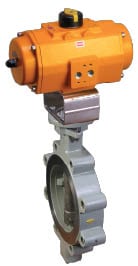
A butterfly valve
for Class VI shut-off
The HP (high-performance) Butterfly Valves (photo) offer Class VI shut-off and an advanced seat design that provides a bi-directional interference and pressure-assisted seal. These valves are available in 2–12-in. sizes with pressure ratings up to 285 psi for 150 class and 740 for 300 class valves. Bodies are available in carbon or stainless steel with Wafer or Lugged flange connections. The HP Series disc is engineered for a quick release from the seat, which reduces torque and wear. — Assured Automation, Clark, N.J.
www.assuredautomation.com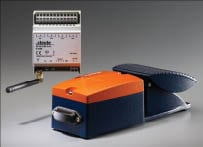
A foot controller
without wires
The advantages of wireless communication are particularly obvious in the case of foot controls; there are no cables to trip over or restrict movements. With the RF GFI/GFIS series (photo), engineers not only can take advantage of such features, but can also use a new wireless standard developed by this firm. Originally developed for medical equipment, this radio standard ensures reliable transmission, is less prone to interference from other radio networks and has the advantage of using a frequency within the license-free, globally-accessible 2.4 GHz waveband. The radio signals are evaluated by a compact receiver, which can be installed in the switching cabinet. — steute Schaltgeräte GmbH & Co. KG, Löhne, Germany
www.steute.com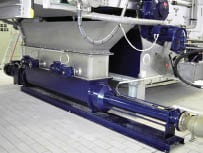
A bridge breaker for
progressing cavity pumps
The aBP-Module (photo) is an intelligent feeding system for progressing cavity pumps for the prevention of bridging. It consists of a top hopper with two inner spoked wheels, which create the effect of moving hopper walls that impart a shearing effect in the medium. The speed difference of the independently adjustable spoked wheels creates the required shearing effect, thereby preventing bridging inside the hopper. The structured surface of the spoked wheels further supports product agitation. — Netzsch Mohnopumpen GmbH, Waldkraiburg, Germany
www.netzsch.com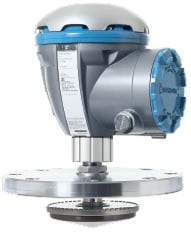
This system has all you need
for tank gauging
The new Raptor system is a complete range of tank-gauging instrumentation, including high-performance, non-contact radar level gauges; temperature and pressure transmitters; water-interface sensors; and inventory management software. Tank hubs are used to communicate with the measuring instruments and control room via standard protocols. Rapor’s bus-powered two-wire Tankbus communication is based on Foundation fieldbus technology, allowing easy startup and integration of all system units. Raptor is built around a new line of Rosemount 0.5-mm precision radar-level gauges, and ultra-stable temperature transmitters with three- or four-wire multiple spot sensors. The gauges use the drip-off antenna concept (photo), and can be used in virtually any liquid, from liquefied petroleum gas to crude oil and asphalt. — Rosemount Tank Radar AB, Göteborg, Sweden
www.rosemount-tankradar.com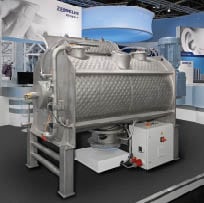
This cooler features a new vessel
and a cooled mixing tool
The Horizontal Cooler EFF (photo) delivers efficient cooling due to a newly designed vessel system and a newly developed, cooled mixing tool with large surface area. The Thermplate mixing vessel consists of a double-wall plate system that is appropriate for the heat transfer. Laser welding and a subsequent process of forming and inflating are used for manufacturing the mixing vessel. Water, steam and hot oils can be used as media. The vessel is made of stainless steel and rated for pressures up to 10 bars. Three cooling cycles are located inside the vessel itself, in its side walls, and in the helical mixing tool. The shape of the mixing tool is designed for increased efficiency. — Zeppelin Systems GmbH, Friedrichshafen, Germany
www.zeppelin-systems.com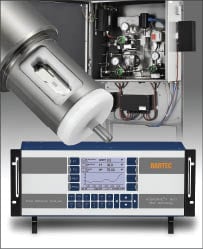
Monitor natural-gas quality
with this drift-free system
By measuring the hydrocarbon (HC) dew point and the moisture in natural gas, the Hygrophil HCDT (photo) monitors the quality of the gas while reliably protecting the plant. The measuring system consists of the display unit Hydrophil F 5673, the moisture sensor L 1660 and the HCDT sensor. Both sensors are installed in a sample system that enables precise, drift-free and fast detection of the HC and water dew point. The precision of the HCDT sensor is ±0.5°C. Measured drift can be excluded because platinum temperature sensors are considered to be drift-free and moving, easy-to-wear-out components have been integrated. As a result, the sensors do not require a cyclic recalibration. — Bartec GmbH, Gotteszell, Germany
www.bartec-benke.de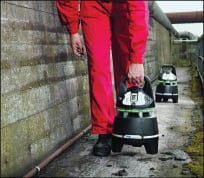
This hazard monitor
also enables corrective action
The X-zone 5000 (photo) combines the advantages of mobile and stationary gas measurement, making it suitable for situations with increased security needs, such as maintenance and industrial plants. Up to six combustible and toxic gases can be measured. The device is placed at locations where a gas leak is likely to occur, and it continuously monitors such areas and warns of a potential hazardous condition. The unit has a relay to trigger other devices, so it can also initiate security measures, such as switching on a ventilation system, closing a gate and so on. The unit includes a Zone 0 hazardous approval so it can be used in potentially explosive environments. — Dräger Safety AG & Co. KGaA, Lübeck, Germany
www.draeger.com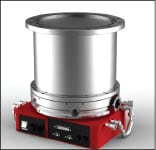
Two new turbo pumps
deliver improved throughputs
This firm has expanded its iXY family of magnetically levitated turbomolecular pumps with the introduction of the STP-iXA2206 and STP-iXA3306 pumps (photo). Developed for solar, glass-coating, semiconductor and LCD-etch applications, the new pumps are fully integrated vacuum pumps that are easy to install and offer a smaller footprint than previous versions. The iXA3306 has a maximum pumping speed of 3,200 L/s and improved throughput performance at high gas flows. The iXA2206 has the same pumping speed as the earlier STP-A2203, yet the maximum throughput has been increased. — Edwards, Crawley, U.K.
www.edwardsvacuum.com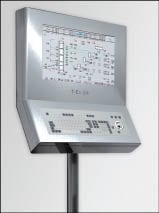
Power supplies with
physical layer diagnostics
Extensive capabilities for physical-layer diagnostics are now a standard integrated feature for all ISbus Series Fieldbus Power Supplies (photo). This integrated functionality enables complete and continuous plant monitoring across Foundation fieldbus H1 segments at nearly no extra cost. In addition to ensuring overload and short-circuit detection, this solution facilitates continuous monitoring of all quality-relevant physical parameters of the fieldbus: trunk voltage and current, signal and noise levels, line unbalance and especially jitter. A serial interface ensures connectivity for readouts from any standard PC, with no need for special drivers or DMTs. — R. Stahl, Waldenburg, Germany
www.stahl.deRupture discs for protecting
plants from overpressure
This firm has added new high performance models to its range of rupture discs. For protection of medium- and high-pressure equipment, the rupture discs model SCD (forward acting) and SCR (compression) have a micro-scored calibrated section with six sectors (instead of four commonly used). This allows a better opening and reduces the risk of petal detachment even at very high bursting pressure. For protection of tanks, reservoirs, silos, and other low-pressure equipment the firm has developed the rupture disc model LPD, a simple, reliable, accurate, and cost-effective solution. Even very low-pressure equipment, such as biogas-plant digesters, can be protected from an overpressure of 5–10 mbar. Also implosion (vacuum) protection is achieved in a very effective way. For detecting rupture of such low-pressure discs, the manufacturer has developed an optical rupture indicator (OFI 04). — Donadon Corbetta, Milan, Italy
www.donadonsdd.com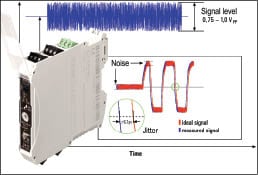
Operate this trackball
with one or two hands
Operating and monitoring systems from the Screen-Tec T-Ex series (photo) feature a trackball that provides users with new operating options. Equipped with five push buttons, the trackball can be operated with one or both hands. The membrane keyboard/trackball unit and the display are suitable for clean rooms and rough environments in the chemical and petrochemical industries. The T-Ex series, which includes 19-, 22- and 24-in. displays, is said to be the first HMI series that can display standard screen formats as well as modern widescreen formats in Zone 1, 2, 21 and 22 hazardous areas. — R. Stahl HMI Systems GmbH, Cologne, Germany
www.stahl-hmi.deAn intelligent valve controller
that keeps getting smarter
The upgraded Neles intelligent valve controller, ND9000, now incorporates a range of improvements that enhance its diagnostics and control performance, robustness and ease and efficiency of commissioning. The time to calibrate the ND9000 has been reduced by 30–75%, depending on the actuator volume. Improved usability is achieved by instant reaction to buttons and a running index showing the progress of the calibration run. When assembled on linear valves, linearization can be effectively performed using an easy, guided process. The firm’s iCV (intelligent control valves) with ND9000 valve controller help process plants to increase process efficiency, says the manufacturer. — Metso Automation, Oy, Helsinki, Finland
www.metso.comPilot operated safety valves
with API compliance
Introduced last August, the pilot operated safety valves (POSVs) include the pop-action Series 810 and modulated-action Series 820 valves. POSVs are typically used in petroleum refineries and gas processing plants, compressors in gas pipline systems and offshore applications. The own-media-controlled POSV have the advantage that the plant can be run close to the set pressure of the valve, which leads to an increase in the capacity utilization, and thus, the efficiency of the plant. POSVs also allow higher, external-back pressures than spring-loaded valves. The valves comply with API 526, and are available in sizes from DN 25 to DN 200. — Leser GmbH & Co. KG, Hamburg, Germany
www.leser.comAn alternative to XRF
for sorting alloys
The Thermoelectric Alloy Sorter (TE-3000) is used to inspect critical piping, flanges, tanks, bearings, finished parts and more. The device can be used for rapid field identification of materials, such as steels, nickel, aluminum, titanium alloys or stainless steels, super alloys, and others. Other applications include detection of platings and plasma coatings, inline and part testing and scrap sorting. Requiring only one second per test, the device is easy to use and extremely safe as no harmful isotopes or x-rays are used. — Koslow Scientific Co., Englewood, N.J.
www.koslow.comSystematic hazard reduction
enhances process safety
The RC1e Process Safety Workstation is a semi-automated system that, in combination with iC Safety software, can be used to investigate thermal and hazardous risk of a wide range of chemical processes. Enhanced reaction control reduces the risk of large-scale failures that endanger lives, equipment and profits. A precision thermostat instantly determines all critical process parameters. The RC1e provides quality data on both desired outcomes and undesired reactive potential to identify and mitigate thermal risk. By collecting realtime heat-flow data and recording a chemical’s reactivity potential, runaway reactions are anticipated and can be avoided through appropriate process development and safety measures. — Mettler Toledo, Schwerzenbach, Switzerland
www.mt.comSpectrometers for when
sensitive light detection is required
Launched last month at Photonics West (San Francisco), the AvaSpec SensLine spectrometers feature high quantum efficiency, back-thinned CCD (charge-coupled device) detectors and the company’s Straylight optical benches. Two models are released with this line; one for measurements in the ultraviolet (UV) to near infrared (NIR) range (200–1,169 nm) with a 0.91-ms integration time; and another with four times higher sensitivity. The instruments are suitable for applications requiring high-sensitivity light detection, such a fluorescence spectroscopy and low light-level detection. — Avantes BV, Eerbeek, the Netherlands
www.avantes.comLevel control for
very harsh process conditions
Monitoring the level of coke drum bottoms in a delayed coker is among the most important process in a petroleum refinery. The LB 490 Tower-Sens detector (photo) has proven to be a reliable and cost-effective solution for this application because it is able to withstand the aggressive environment, which includes high temperatures and foam, extensive caking as well as high-pressure water jet. All components of the measuring system are mounted on the outer wall of the coke drum, thus unaffected by the harsh conditions inside. The Tower-Sens uses a detector length of up to 8 m, and continuously monitors foam as well as the coke level in the drum online and accurately. — Berthold Technologies GmbH & Co. KG, Bad Wildbad, Germany
www.berthold.comA quick-to-install
wireless data logging system
Newsteo (photo) is a central, wireless monitoring system suitable for applications such as warehousing, cool-room monitoring, food distribution, laboratories and pharmaceutical production monitoring. The “plug-and-play” system relies on wireless dataloggers continuously storing and transmitting captured data to a receiver station, which also serves as a central monitor. The device has a transmission range of up to 900 m. The system can be deployed in minutes; simply install the software, connect the receiver to a USB port on a PC and place the data logger. — CiK Solutions GmbH, Karlsruhe, Germany
www.cik-solutions.comTurbine control and monitoring
gets enhanced
This firm has enhanced its metsoDNA Turbine Control by integrating in fast turbine control and other features to improve its cost efficiency and ease of maintenance. The fast, redundant control handles control cycles down to 5 ms for any size turbine. A new servo valve control I/O can control any milliamp range of servo valves. Vibration monitoring and protection features are integrated into the I/O card and process controllers, and new I/O cards can read standard accelerometers and eddy current sensors. Measurements can be used for protection and normal online monitoring, as well as more developed diagnostic purposes. The integration eliminates many extra transmitters and amplifiers traditionally required. — Metso Corp., Helsinki, Finland
www.metso.com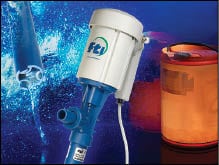
Eliminate manual fluid transfers
with these pumps
The Finish Thompson EF drum pump (photo) includes a shorter 16-in. tube length option that is ideal for transferring liquids, such as oils, acids and detergents from small drums, buckets and carboys. The pump is capable of delivering flowrates up to 64 L/min at discharge pressures up to 6.1 m. As an alternative to manual transfer methods and more efficient than hand pumps, the EF pumps eliminate the problems associated with heavy containers while reducing the risk of spillage. The EF Series can also be supplied with longer tube lengths (27, 40 and 48 in.) for larger containers. — Michael Smith Engineers Ltd., Woking, U.K.
www.michael-smith-engineers.co.ukEnergy-saving decanters
for dewatering of sludge
With the new generation of sludgeforce decanters, the energy consumption has been reduced to 0.7 kWh/m3 compared to 1.3–1.5 kWh/m3 required by conventional decanters. This achievement has been made possible by design changes, such as constructing the machine for extreme pond depth — the ratio of the diameter of the solids discharge to the internal diameter of the bowl. The sludgeforce has a pond depth of less than 0.5 compared to 0.6 for conventional units. Besides reduced energy consumption, the flocculant requirement is also cut by up to 2 kg/m3 — a 25% savings in operational costs for polymer consumption, says the manufacturer. The new decanter line covers the ranges from 1 to 200 m3/h. — GEA Westfalia Separator Group, Oelde, Germany
www.westfalia-separator.com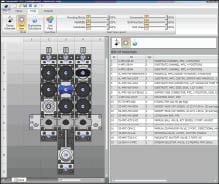
An interactive software tool
for assembling process analyzers
Featuring 3D CAD output, live flow evaluation and integrated flow data, the updated MPC Configurator (photo) makes it easy to develop complete process analyzer and sample systems. The program provides engineers with an interactive tool to build and assemble ANSI/ISA 76.00.02-compliant miniature modular designs prior to the purchase process. The software is available for download from the company’s website, or as a CD installation. — Swagelok Co., Solon, Ohio
www.swagelok.comNext-generation
cooling water technology
GenGuard 8000 offers the capability to use less lower-quality water in the cooling process, while avoiding corrosion and fouling problems. This extension of the existing GenGuard product line also reduces the need for sulfuric acid for pH control in cooling water systems. GenGuard 8000’s chemistry covers the full pH spectrum from neutral to alkaline, and incorporates the latest deposit and corrosion additives. The product is designed to work in conjunction with the firm’s process control and knowledge-management system, TrueSense. — GE Power and Water, Trevose, Pa.
www.ge.comThese labels stick when needed
and are easily removed
The new CIL-9100R range of peelable labels provides excellent initial tack, yet can be cleanly removed without leaving any adhesive residue. These labels can withstand autoclaving, extreme temperatures (–196 to 388°C), cryostorage, chemicals and solvents. Sample and specimen variable data can be added on demand using an existing PC and laser or thermal-transfer printer. — Computer Imprintable Label Systems Ltd., Worthing, U.K.
www.cil-international.comModeling exposure scenarios
for REACH compliance
EasyTRA is a new software tool for modeling complex exposure scenarios for REACH compliance. It is said to be the first software application that enables chemical companies to produce, automatically, extended safety data sheets (eSDS) containing appendices with details of all safe applications, which must be produced for all REACH-registered substances. Based on a step-by-step process known as targeted risk assessment (TRA), EasyTRA works out the human health and environmental risks associated with the use of a specific substance. The application is said to be faster than other solutions, and the only one to offer the full set of functionalities required. — Jansen-Systems GmbH, Solingen, Germany
www.jansen-systems.de.jpeg)